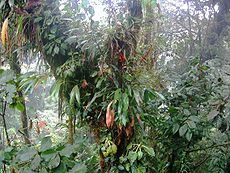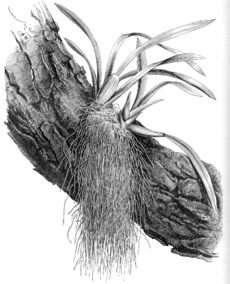- Epifita
-
Epifita
 Árbol que soporta sobre tronco y ramas numerosas plantas epifitas, en el Parque Santa Elena de Costa Rica
Árbol que soporta sobre tronco y ramas numerosas plantas epifitas, en el Parque Santa Elena de Costa Rica
Epifita (del griego epi sobre y phyton planta) se refiere a cualquier planta que crece sobre otro vegetal usándolo solamente como soporte, pero que no lo parasita. Estas plantas son llamadas en ocasiones "planta aéreas", ya que no enraizan sobre el suelo. Sin embargo, existen muchas especies de algas, incluyendo las marinas, que son epifitas sobre otras especies acuáticas (marinas o acuáticas angiospermas)Las epifitas utilizan la fotosíntesis para proveerse de energía y (las que no son acuáticas) obtienen humedad del aire o de la lluvia que se deposita sobre la superficie de su anfitrión.
Las raíces pueden desarrollarse primariamente por adhesión y las estructuras especializadas (como las escamas y copas) son las que recogen y mantienen la humedad.
Las epifitas no parasitan a su anfitrión, sino que crecen independientemente obteniendo únicamente apoyo físico. La ventaja más evidente respecto a otras hierbas restringidas a la tierra es que reciben más luz en los umbríos ecosistemas boscosos y se mantienen lejos de los herbívoros. Sin embargo pueden desarrollarse tan apretadamente que llegan a dañar la planta anfitriona.
Las epifitas más conocidas incluyen los musgos, líquenes, orquídeas, helechos y bromelias (como la Tillandsia), aunque se pueden encontrar en todos los grupos principales del reino vegetal. Las acumulaciones de grandes epifitas se dan más abundantemente en las selvas húmedas tropicales y bosques templados lluviosos, pero tanto líquenes como musgos se encuentran en cualquier entorno con árboles.
El primer trabajo monográfico importante sobre la ecología de las epifitas fue escrito por A.F.W. Schimper (Die epiphytische Vegetation Amerikas, 1888).
Las epífitas son una de las seis subdivisiones del sistema de Raunkiær
Bibliografía
- Alwyn H. Gentry, C. H. Dodson: Diversity and Biogeography of Neotropical Vascular Epiphytes. In: Annals of the Missouri Botanical Garden. 74, Nr. 2, 1987, S. 205–233
- Armbruster, P., R. A. Hutchinson, and P. Coatgrave. Factors influencing community structure in a South American tank bromeliad fauna. Oikos 96:2002. 225–234.
- Andre, H. 1986. Notes on the ecology of corticolous epiphyte dwellers. 4. Actinedida (especially Tydeidae) and Gamasida (especially Phytoselidae). Acarologia 27:107-115.
- Armstrong, R. A. 1989. Dispersal, establishment and survival of soredia and fragments of the lichen Hypogymnia physodes (L.) Nyl. Botanical Gazette 239-245.
- Ball, G. E. & D. Shpeley. Carabidae (Coleoptera). Llorente-Bousquets, J., E. González-Soriano, and N. Papavero, editors. Biodiversidad, Taxonomía y Biogeografía de Artrópodos de México. Hacia una Síntesis de su conocimiento vol. II:2000. 363–399.Universidad Nacional Autónoma de México. Mexico City, Mexico.
- Benzing, D. H. An investigation of two bromeliad myrmecophytes: Tillandsia butzii Mez, T. caput-medusae E. Morren, and their ants. Bull. Torrey Botanical Club 97:1970. 109–115. CrossRef
- Benzing, D. H. Vascular epiphytes: a survey with special reference to their interactions with other organisms. Sutton, S. L., T. C. Whitmore, and A. C. Chadwick, editors. Tropical rain forest: ecology and management 1984. 11–24.Blackwell Scient. Pub.. Oxford, UK.
- Benzing, D. H. Foliar specializations for animal assisted nutrition in Bromeliaceae. Juniper, B. E. and T. R. E. Southwood, editors. Insects and the plant surface 1986. 235–256.Edward Arnold. London, UK.
- Benzing, D. H. Vascular epiphytes. General biology and related biota 1990. Cambridge University Press. New York.
- Benzing, D. H. Bromeliaceae: profile of an adaptive radiation 2000. Cambridge University Press. New York.
- Berryman, S. D. & B. McCune. 2001b. Estimating epiphytic macrolichen biomass based on lichen community data in the Central Cascade forest of western Oregon, manuscript.
- Beutelspacher, C. R. Fauna de Tillandsia caput-medusae E. Morren, 1880 (Bromeliaceae). An. Inst. Biol. Univ. Nal. Autón. México Ser. Zool. 1:1972. 25–30.
- Beutelspacher, C. R. Bromeliáceas como ecosistemas. Con especial referencia a Achmea bracteata (Swartz) Griseb. Edit 1999. Plaza y Valdés. Mexico City, México.
- Boucher, V. L. and D. F. Stone. 1992. Epiphytic lichen biomass. Pages 583-599 in G. C. Carroll and D. T. Wicklow (eds.), The Fungal Community. Its Organization and Role in the Ecosystem. Marcel Decker, New York.
- Brown, M.J., Jarman, S.J., and Kantvilas, G. 1994. Conservation and reservation of non-vascular plants in Tasmania, with special reference to lichens, Biodiversity and Conservation 3:263-278.
- Campbell, J., S. K. Stevenson, & D. S. Coxson. 1999. Estimating epiphyte abundance in high-elevation forests of northern British Columbia. Selbeyana 20:261-267.
- Castaño-Meneses, R. G. Estructura de la comunidad de artrópodos epífitos y su papel en el crecimiento de Tillandsia violacea (Bromeliaceae) en un bosque templado de Hidalgo, México. Tesis doctoral 2002. Facultad de Ciencias, UNAM. Mexico City, Mexico.
- Castillo-Campos, G. Vegetación y flora del Municipio de Xalapa, Veracruz 1991. MAB-Unesco, Instituto de Ecología, A.C. y H. Ayuntamiento de Xalapa. Veracruz, Mexico.
- Clement, J. P. & D. C. Shaw. 1999. Crown structure and the distribution of epiphyte functional group biomass in old-growth Pseudotsuga menziesii trees. Ecoscience 6:243-254.
- Cowling, R. M. and M. J. Samways. Predicting global patterns of endemic plant species richness. Biodiv. Lett. 2:1994. 127–131. CrossRef, CSA
- Darlington Jr, P. J. Carabidae on tropical islands, especially the West Indies. Biotropica 2:1970. 7–15. CrossRef
- Davidson, D. W., R. R. Snelling, and J. T. Longino. Competition among ants for myrmecophytes and the significance of plant trichomes. Biotropica 21:1989. 64–73. CrossRef, CSA
- Delamare-Debouteville, C. Étude quantitative du peuplemente animal des sols suspendu et des ephyphytes en forêt tropicale. Compt. Rend. de l′Acad. du Sci. 226:1948. 1544–1546.
- Denison, W. C. 1979. Lobaria oregana, a nitrogen-fixing lichen in old-growth Douglas fir forests. Pp. 266-275 in Gordon, J. C., C. T. Wheeler, and D. A. Perry (eds.), Symbiotic Nitrogen Fixation in the management of Temperate Forests-- Proceedings of a workshop.
- Dettki, H. and P.-A. Esseen. 1998. Epiphytic macrolichens in managed and natural forest landscapes: a comparison at two spatial scales. Ecography 21:613-624.
- Edwards, R. Y., J. Soos, and R. W. Ritchey. 1960. Quantitative observations on epidendric lichens used as food by caribou. Ecology 41:425-431.
- E. Montes De Oca12, G. E. Ball2, J. R. Spence3, Diversity of Carabidae (Insecta, Coleoptera) in Epiphytic Bromeliaceae in Central Veracruz, Mexico. Department Biodiversidad y Ecología Animal, Instituto de Ecología, A.C., Km 2.5 Carretera Antigua, a Coatepec no. 351 Congregación El Haya, C.P. 91070 Xalapa, Veracruz, Mexico.
- Esseen, P.-A. 1985. Litter fall of epiphytic macrolichens in two old Picea abies forests in Sweden. Canadian Journal of Botany 63:980-987.
- Floren, A. and K. E. Linsenmair. Non-equilibrium communities of Coleoptera in trees in a lowland rain forest of Borneo. Biotropica 4:1998. 55–67.
- Fritz, O. & K. Larsson. 1997. Betydelsen av skoglig kontinuitet for rodlistade lavar. En studie av hallandsk bokskog. Svensk Botanisk Tidskr. 90:241-262. (The significance of long forest continuity to red-listed lichens. A study of beech forest in the province of Halland, SW Sweden.)
- García-Franco, J. G. and C. M. Peters. Patrón espacial y abundancia de Tillandsia spp. a través de un gradiente altitudinal en los Altos de Chiapas, México. Brenesia 27:1987. 35–45.
- Gauslaa, Y. & K. A. Solhaug. 2001. Fungal melanins as a sun screen for symbiotic green algae in the lichen Lobaria pulmonaria. Oecologia 126:462-471.
- Geiser, L.H., Derr, C.C., and Dillman, K.L. 1994. Air quality monitoring on the Tongass National Forest. Methods and baselines using lichens, United States Department of Agriculture, Forest Service, Alaska Region, Report R10-TB-46, USA
- Gentry, A. H. and C. H. Dodson. Diversity and biogeography of neotropical vascular epiphytes. Ann. Mo. Bot. Gard. 74:1987. 205–233. CrossRef
- Gering, J. C. and T. O. Crist. Patterns of beetle (Coleoptera) diversity in crowns of representative tree species in an old-growth temperate deciduous forest. Selbyana 21:2000. 38–47.
- Giddings, L. and Y. K. Mehltreter. Base de datos del clima de México. Extraídos de ERIC (2000) 2003. Instituto de Ecología. Xalapa, Mexico.
- Gilmartin, A. J. Ecuador. Bromeliad country. Broml. Soc. Bull. 14:1964. 4–7.
- Gómez, C. M. Atlas climático del Municipio de Xico (Estado de Veracruz) 1991. Instituto de Ecología. Xalapa, Mexico.
- Greeney, H. F. The insect of plant-held waters: a review and bibliography. J. Trop. Ecol. 17:2001. 241–260. CrossRef, CSA
- Hietz, P. and U. Hietz-Seifert. Epífitas de Veracruz. Guía ilustrada para las Regiones de Xalapa y SpaceqqLos Tuxtlas, Veracruz/Epiphytes of Veracruz. An illustrated guide for the regions of Xalapa and Los Tuxtlas, Veracruz 1994. Instituto de Ecología. Xalapa, Veracruz, Mexico.
- Hietz, P. and U. Hietz-Seifert. Structure and ecology of epiphyte communities of a cloud forest in central Veracruz, Mexico. Vegetat. Sci. 6:1995. 719–728. CrossRef
- Lucky, A., T. L. Erwin, and J. D. Witman. Temporal and spatial diversity and distribution of arboreal Carabidae (Coleoptera) in a western Amazonian Rain Forest. Biotropica 34:2002. 376–386. Bioone, CSA
- Magurran, A. Ecological diversity and measurement 1988. Princeton University Press. Princeton, NJ.
- McCune, B., R. Rosentreter, J. M. Ponzetti, and D. C. Shaw. 2000. Epiphyte habitats in an old conifer forest in western Washington, USA. Bryologist 103:417-427.
- Murillo, R. M., J. G. Palacios, J. M. Labouglr, E. M. Hentschel, J. E. Llorente, K. Luna, P. Rojas, and S. Zamudio. Variación estacional de la entomofauna asociada a Tillandsia spp. en una zona de transición biótica. Southwest. Entomol. 8:1983. 292–302. CSA
- Nadkarni, N. M. and J. T. Longino. Invertebrates in canopy and ground organic matter in a Neotropical Montane Forest, Costa Rica. Biotropica 22:1990. 286–289. CrossRef, CSA
- Olmsted, I. C., A. Dejean, and R. R. Snelling. Tree epiphyte-ant relationships of the low inundated forest in Sian Ka′an Biosphere Reserve, Quintana Roo, México. Biotropica 27:1995. 57–70. CrossRef, CSA
- Palacios-Vargas, J. G. Collembola asociados a Tillandsia en el Derrame lávico del Chichinautzin, Morelos, México. Southwest. Entomol. 6:1981. 87–98. CSA
- Palacios-Vargas, J. G. and G. Castaño-Meneses. Collembola associated with Tillandsia violacea (Bromeliaceae) in mexican Quercus-Abies forests. Pedobiologica 46:2001. 395–403. CSA
- Paoletti, M. G., R. A. J. Taylor, B. R. Stinner, D. H. Stinner, and D. H. Benzing. Diversity of soil fauna in the canopy and forest floor of a Venezuelan cloud forest. J. Trop. Ecol. 7:1991. 373–383. CSA
- Picado, C. Les Bromeliacées epiphytes, considerés comme milieu biologique. Bul. Scient. Fr. Belg. 46:1913. 215–360.
- Richardson, B. A. The bromeliad microcosm and the assessment of faunal diversity in a neotropical forest. Biotropica 31:1999. 321–336. CrossRef
- Rickson, F. R. Absorption of animal tissue breakdown products into a plant stem. The feeding of a plant by ants. Am. J. Bot. 66:1979. 87–90. CrossRef
- Rico-Gray, V., J. T. Barber, L. B. Thien, E. G. Ellgaard, and J. J. Toney. An unusual animal-plant interaction: feeding of Schomburgkia tibicinis (Orchidaceae) by ants. Am. J. Bot. 76:1989. 603–608. CrossRef, CSA
- Schimper, A.F.W. (1888): Die epiphytische Vegetation Amerikas. Fischer, Jena. Digitalisat. Project Gutenberg eText
- Stuntz, S. The influence of epiphytes on arthropods in the tropical forest canopy. PhD dissertation 2001. Bayerischen Julius-Maximilians-Universität Würzburg. München, Germany.
- Stuntz, S., U. Simon, and G. Zotz. Assessing the potential influence of vascular epiphytes on arthropod diversity in tropical tree crowns: hypotheses, approaches and preliminary data. Selbyana 20:1999. 276–283.
- Stuntz, S., Ch Ziegler, U. Simon, and G. Zotz. Diversity and structure of the arthropod fauna within three canopy epiphyte species in central Panama. J. Trop. Ecol. 18:2002. 161–176. CrossRef, CSA
- Treseder, K. K., D. W. Davidson, and J. R. Ehleringer. Absorption of ant-provided carbon dioxide and nitrogen by a tropical epiphyte. Nature 275:1995. 137–139. CrossRef
- Williams, D. D. and B. W. Feltmate. Aquatic insects 1992. CAB International, University Arizona Press. Wallingford (UK)/Tucson, AZ.
Enlaces externos
 Wikimedia Commons alberga contenido multimedia sobre epifita.
Wikimedia Commons alberga contenido multimedia sobre epifita.
 Wikcionario tiene definiciones para epifita.
Wikcionario tiene definiciones para epifita.- BBC: cuidados de las plantas epifitas
- Lankester Botanical Garden
Categorías: Plantas epifíticas | Términos botánicos
Wikimedia foundation. 2010.

